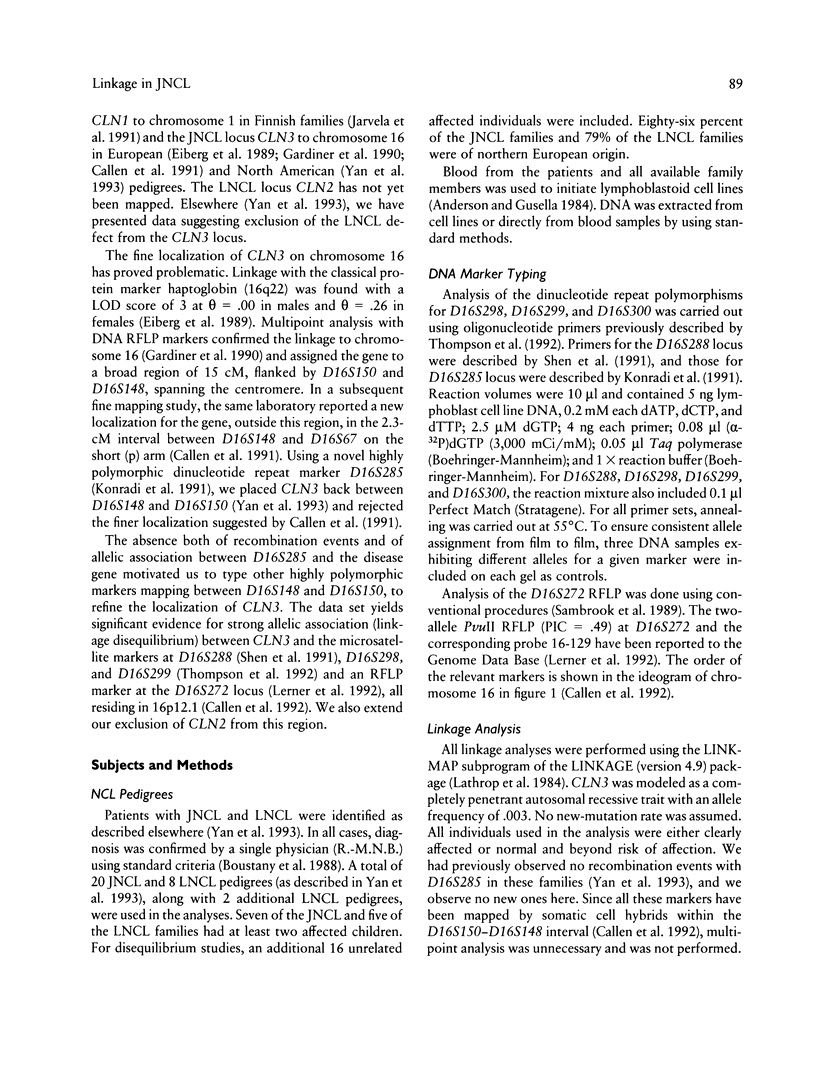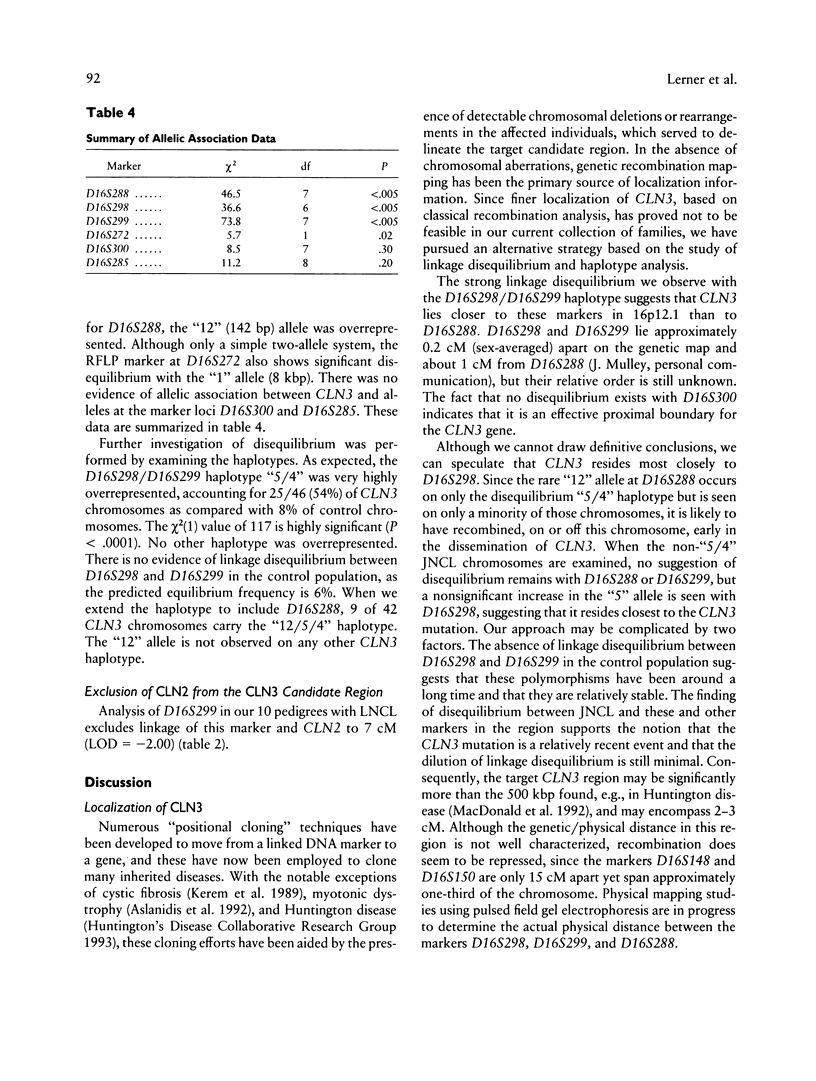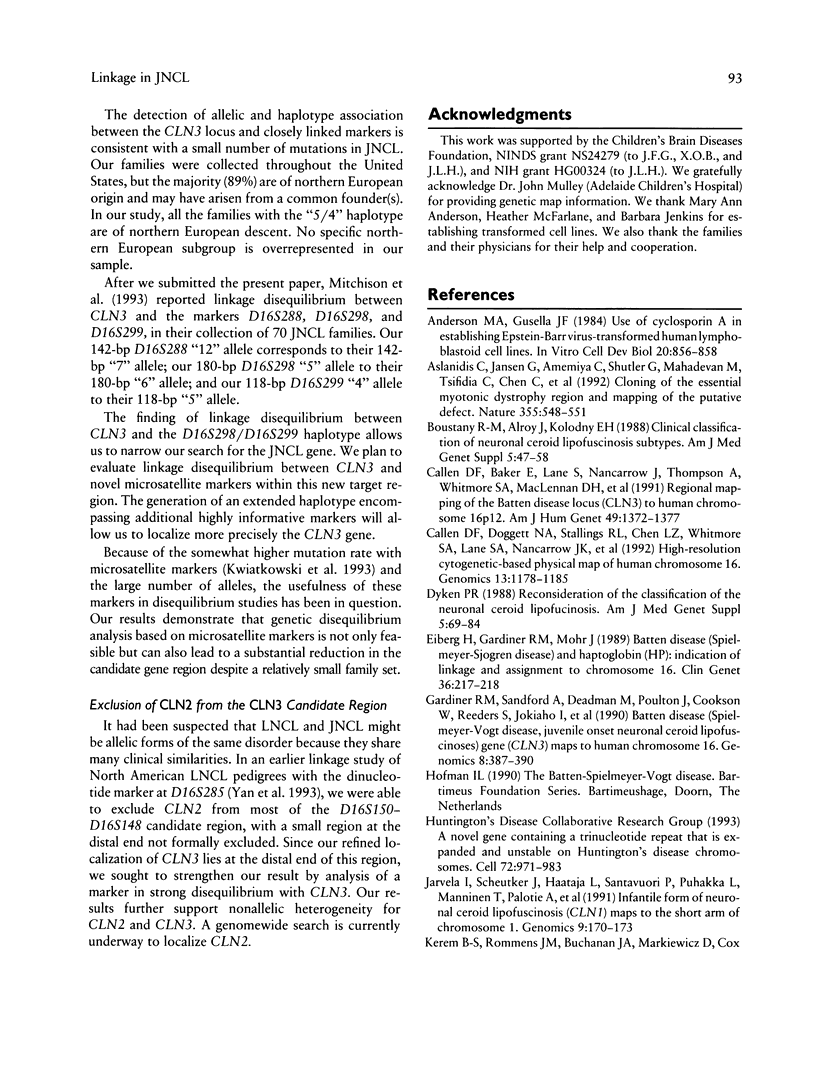Abstract
The neuronal ceroid lipofuscinoses (NCL; Batten disease) are a collection of autosomal recessive disorders characterized by the accumulation of autofluorescent lipopigments in the neurons and other cell types. Clinically, these disorders are characterized by progressive encephalopathy, loss of vision, and seizures. CLN3, the gene responsible for juvenile NCL, has been mapped to a 15-cM region flanked by the marker loci D16S148 and D16S150 on human chromosome 16. CLN2, the gene causing the late-infantile form of NCL (LNCL), is not yet mapped. We have used highly informative dinucleotide repeat markers mapping between D16S148 and D16S150 to refine the localization of CLN3 and to test for linkage to CLN2. We find significant linkage disequilibrium between CLN3 and the dinucleotide repeat marker loci D16S288 (chi 2(7) = 46.5, P < .005), D16S298 (chi 2(6) = 36.6, P < .005), and D16S299 (chi 2(7) = 73.8, P < .005), and also a novel RFLP marker at the D16S272 locus (chi 2(1) = 5.7, P = .02). These markers all map to 16p12.1. The D16S298/D16S299 haplotype "5/4" is highly overrepresented, accounting for 54% of CLN3 chromosomes as compared with 8% of control chromosomes (chi 2 = 117, df = 1, P < .001). Examination of the haplotypes suggests that the CLN3 locus can be narrowed to the region immediately surrounding these markers in 16p12.1. Analysis of D16S299 in our LNCL pedigrees supports our previous finding that CLN3 and CLN2 are different genetic loci. This study also indicates that dinucleotide repeat markers play a valuable role in disequilibrium studies.
Full text
PDF






Selected References
These references are in PubMed. This may not be the complete list of references from this article.
- Anderson M. A., Gusella J. F. Use of cyclosporin A in establishing Epstein-Barr virus-transformed human lymphoblastoid cell lines. In Vitro. 1984 Nov;20(11):856–858. doi: 10.1007/BF02619631. [DOI] [PubMed] [Google Scholar]
- Aslanidis C., Jansen G., Amemiya C., Shutler G., Mahadevan M., Tsilfidis C., Chen C., Alleman J., Wormskamp N. G., Vooijs M. Cloning of the essential myotonic dystrophy region and mapping of the putative defect. Nature. 1992 Feb 6;355(6360):548–551. doi: 10.1038/355548a0. [DOI] [PubMed] [Google Scholar]
- Boustany R. M., Alroy J., Kolodny E. H. Clinical classification of neuronal ceroid-lipofuscinosis subtypes. Am J Med Genet Suppl. 1988;5:47–58. doi: 10.1002/ajmg.1320310608. [DOI] [PubMed] [Google Scholar]
- Callen D. F., Baker E., Lane S., Nancarrow J., Thompson A., Whitmore S. A., MacLennan D. H., Berger R., Cherif D., Järvelä I. Regional mapping of the Batten disease locus (CLN3) to human chromosome 16p12. Am J Hum Genet. 1991 Dec;49(6):1372–1377. [PMC free article] [PubMed] [Google Scholar]
- Callen D. F., Doggett N. A., Stallings R. L., Chen L. Z., Whitmore S. A., Lane S. A., Nancarrow J. K., Apostolou S., Thompson A. D., Lapsys N. M. High-resolution cytogenetic-based physical map of human chromosome 16. Genomics. 1992 Aug;13(4):1178–1185. doi: 10.1016/0888-7543(92)90035-q. [DOI] [PubMed] [Google Scholar]
- Dyken P. R. Reconsideration of the classification of the neuronal ceroid-lipofuscinoses. Am J Med Genet Suppl. 1988;5:69–84. doi: 10.1002/ajmg.1320310610. [DOI] [PubMed] [Google Scholar]
- Eiberg H., Gardiner R. M., Mohr J. Batten disease (Spielmeyer-Sjøgren disease) and haptoglobins (HP): indication of linkage and assignment to chr. 16. Clin Genet. 1989 Oct;36(4):217–218. doi: 10.1111/j.1399-0004.1989.tb03193.x. [DOI] [PubMed] [Google Scholar]
- Gardiner M., Sandford A., Deadman M., Poulton J., Cookson W., Reeders S., Jokiaho I., Peltonen L., Eiberg H., Julier C. Batten disease (Spielmeyer-Vogt disease, juvenile onset neuronal ceroid-lipofuscinosis) gene (CLN3) maps to human chromosome 16. Genomics. 1990 Oct;8(2):387–390. doi: 10.1016/0888-7543(90)90297-8. [DOI] [PubMed] [Google Scholar]
- Järvelä I., Schleutker J., Haataja L., Santavuori P., Puhakka L., Manninen T., Palotie A., Sandkuijl L. A., Renlund M., White R. Infantile form of neuronal ceroid lipofuscinosis (CLN1) maps to the short arm of chromosome 1. Genomics. 1991 Jan;9(1):170–173. doi: 10.1016/0888-7543(91)90235-7. [DOI] [PubMed] [Google Scholar]
- Kerem B., Rommens J. M., Buchanan J. A., Markiewicz D., Cox T. K., Chakravarti A., Buchwald M., Tsui L. C. Identification of the cystic fibrosis gene: genetic analysis. Science. 1989 Sep 8;245(4922):1073–1080. doi: 10.1126/science.2570460. [DOI] [PubMed] [Google Scholar]
- Konradi C., Ozelius L., Yan W., Gusella J. F., Breakefield X. O. Dinucleotide repeat polymorphism (D16S285) on human chromosome 16. Nucleic Acids Res. 1991 Oct 11;19(19):5449–5449. doi: 10.1093/nar/19.19.5449. [DOI] [PMC free article] [PubMed] [Google Scholar]
- Kwiatkowski D. J., Dib C., Slaugenhaupt S. A., Povey S., Gusella J. F., Haines J. L. An index marker map of chromosome 9 provides strong evidence for positive interference. Am J Hum Genet. 1993 Dec;53(6):1279–1288. [PMC free article] [PubMed] [Google Scholar]
- Lathrop G. M., Lalouel J. M., Julier C., Ott J. Strategies for multilocus linkage analysis in humans. Proc Natl Acad Sci U S A. 1984 Jun;81(11):3443–3446. doi: 10.1073/pnas.81.11.3443. [DOI] [PMC free article] [PubMed] [Google Scholar]
- Lerner T., Wright G., Leverone B., Dackowski W., Shook D., Anderson M. A., Klinger K., Callen D., Landes G. Molecular analysis of human chromosome 16 cosmid clones containing NotI sites. Mamm Genome. 1992;3(2):92–100. doi: 10.1007/BF00431252. [DOI] [PubMed] [Google Scholar]
- MacDonald M. E., Novelletto A., Lin C., Tagle D., Barnes G., Bates G., Taylor S., Allitto B., Altherr M., Myers R. The Huntington's disease candidate region exhibits many different haplotypes. Nat Genet. 1992 May;1(2):99–103. doi: 10.1038/ng0592-99. [DOI] [PubMed] [Google Scholar]
- Mitchison H. M., Thompson A. D., Mulley J. C., Kozman H. M., Richards R. I., Callen D. F., Stallings R. L., Doggett N. A., Attwood J., McKay T. R. Fine genetic mapping of the Batten disease locus (CLN3) by haplotype analysis and demonstration of allelic association with chromosome 16p microsatellite loci. Genomics. 1993 May;16(2):455–460. doi: 10.1006/geno.1993.1210. [DOI] [PubMed] [Google Scholar]
- Rider J. A., Rider D. L. Batten disease: past, present, and future. Am J Med Genet Suppl. 1988;5:21–26. doi: 10.1002/ajmg.1320310606. [DOI] [PubMed] [Google Scholar]
- Thompson A. D., Shen Y., Holman K., Sutherland G. R., Callen D. F., Richards R. I. Isolation and characterisation of (AC)n microsatellite genetic markers from human chromosome 16. Genomics. 1992 Jun;13(2):402–408. doi: 10.1016/0888-7543(92)90260-y. [DOI] [PubMed] [Google Scholar]
- Wisniewski K. E., Rapin I., Heaney-Kieras J. Clinico-pathological variability in the childhood neuronal ceroid-lipofuscinoses and new observations on glycoprotein abnormalities. Am J Med Genet Suppl. 1988;5:27–46. doi: 10.1002/ajmg.1320310607. [DOI] [PubMed] [Google Scholar]
- Yan W., Boustany R. M., Konradi C., Ozelius L., Lerner T., Trofatter J. A., Julier C., Breakefield X. O., Gusella J. F., Haines J. L. Localization of juvenile, but not late-infantile, neuronal ceroid lipofuscinosis on chromosome 16. Am J Hum Genet. 1993 Jan;52(1):89–95. [PMC free article] [PubMed] [Google Scholar]


